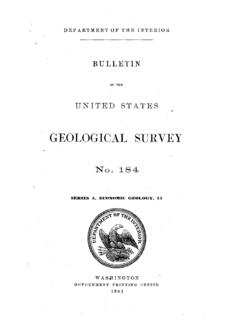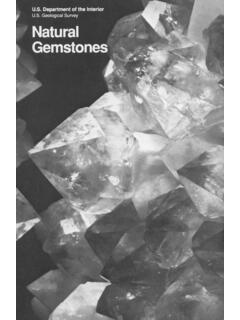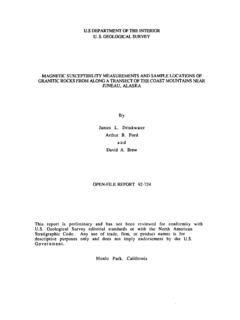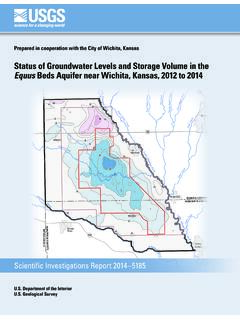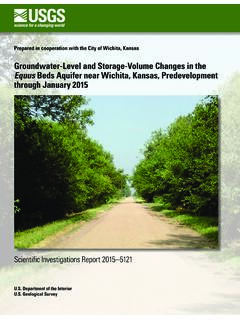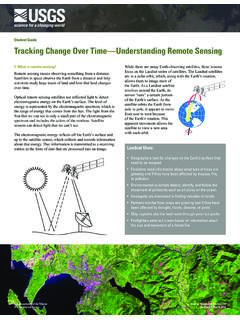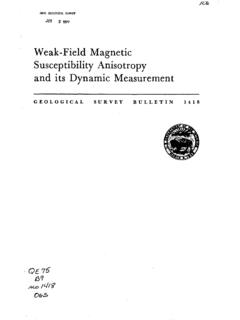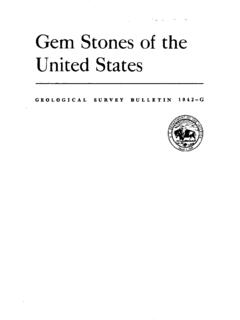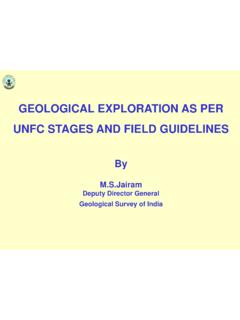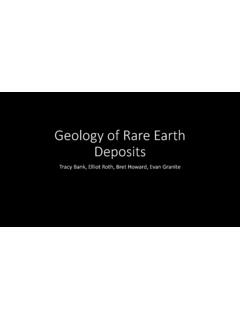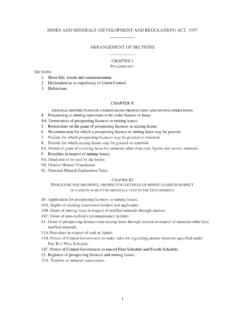Transcription of Principles of a Resource/Reserve Classification For Minerals
1 GEOLOGICAL survey CIRCULAR 831 Principles of a Resource/Reserve Classification For Minerals L Principles of a Resource/Reserve Classification For Minerals By the Bureau of mines and the Geological survey GEOLOGICAL survey CIRCULAR 831 A revision of the Classification system published as Geological survey Bulletin 1450-A 1980 United States Department of the Interior CECIL D. ANDRUS, Secretary Geological survey H. William Menard, Director Library of Congress Cataloging in Publication Data United States. Bureau of mines . Principles of a Resource/Reserve Classification for Minerals . (Geological survey circular ; 831) Edition for 1976 published under title: Principles of the mineral resource Classification system of the Bureau of mines and Geological survey . Bibliography: p. 1. mines and mineral resources-United States- Classification . I. United States. Geological survey .
2 II. Title. III. Series: United States. Geological survey . Circular; 831. no. 831 [TN153] [553'.01'2] 80-607901. Free on application to Branch of Distribution, Geological survey 1200 South Eads Street, Arlington, VA 22202 CONTENTS Page Introduction_____ 1 Resource/Reserve definitions ---------------------------------------- ---------------1 Guidelines for Classification of mineral resources ---------------------------------------3 ILLUSTRATIONS Page FIGURE 1. Diagrammatic illustration of major elements of mineral-resource Classification -----------------------------5 2. Diagrammatic illustration of reserve base and inferred reserve base Classification categories -------------------5 iii Principles of a Resource/Reserve Classification for Minerals By the BUREAU OF mines and the GEOLOGICAL survey INTRODUCTION Through the years, geologists, mining engineers, and others operating in the Minerals field have used various terms to describe and classify mineral resources, which as.
3 Defined herein include energy materials. Some of these terms have gained wide use and acceptance, although they are not always used with precisely the same meaning. Staff members of the Bureau of mines and the Geological survey collect information about the quantity and quality of all mineral resources, but from different perspectives and with different purposes. In 1976, a team of staff members from both agencies developed a common Classification and nomenclature, which was 'published as Geological survey Bulletin 1450-A-" Principles of the Mineral Resource Classification System of the Bureau of mines and Geological survey ." Experience with this resource Classification system showed that some changes were necessary in order to make it more workable in practice and more useful in long-term planning. Therefore, representatives of the Geological survey and the Bureau of mines collaborated to revise Bulletin 1450-A.
4 Long-term public and commercial planning must be based on the probability of discovering new deposits, on developing economic extraction proc-esses for currently unworkable deposits, and on knowing which resources are immediately available. Thus, resources must be continuously reassessed in the light of new geologic knowledge, of progress in science and technology, and of shifts in economic and political conditions. To best serve these planning needs, known resources should be classified from two standpoints: (1) purely geologic or physical/chemical characteristics-such as grade, quality, tonnage, thickness, and depth-of 1 the material in place: and (2) profitability analyses based on costs of extracting and marketing the material in a given economy at a given time. The former constitutes important objective scientific information of the resource and a relatively un-changing foundation upon which the latter more variable economic delineation can be based.
5 The revised Classification system, designed generally for all mineral materials, is shown graphically in figures 1 and 2 (see page 5); its com-ponents and their usage are described in the text. The Classification of mineral and energy resources is necessarily arbitrary, because definitional criteria do not always coincide with natural boun-daries. The system can be used to report the status of mineral and energy-fuel resources for the Na-tion or for specific areas. Resource/Reserve DEFINITIONS A dictionary definition of resource, "something in reserve or ready if needed," has been adapted for mineral and energy resources to comprise all materials, including those only surmised to exist, that have present or anticipated future value. Resource. -A concentration of naturally occurring solid, liquid, or gaseous material in or on the Earth's crust in such form and amount that economic extraction of a commodity from the concentration is currently or potentially feasible.
6 Original amount of a resource before production. Identified whose location, grade, quality, and quantity are known or estimated from specific geologic evidence. Identified resources include economic, marginally economic, and subeconomic com-ponents. To reflect varying degrees of geologic (Identified Resources-Continued) certainty, these economic divisions can be sub-divided into measured, indicated, and Demonstrated. -A term for the sum of meas-ured plus indicated. is computed from dimensions revealed in outcrops, trenches, workings, or drill holes; grade and( or) quality are computed from the results of detailed sampling. The sites for inspection, sampling, and measurement are spaced so closely and the geologic character is so well de-fined that size, shape, depth, and mineral content of the resource are well established. and grade and( or) quality are computed from information similar to that used for measured resources, but the sites for inspection, sampling, and measurement are far-ther apart or are otherwise less ade-quately spaced.
7 The degree of assur-ance, although lower than that for measured resources, is high enough to assume continuity between points of observation. are based on an as-sumed continuity beyond measured and( or) indicated resources, for which there is geologic evidence. Inferred resources may or may not be supported by samples or measurements. Reserve Base. -That part of an identified resource that meets specified minimum physical and chemical criteria related to current mining and production practices, including those for grade, quality, thickness, and depth. The reserve base is the in-place demonstrated (measured plus indicated) resource from which reserves are estimated. It may encompass those parts of the resources that have a reasonable potential for becoming economical-ly available within planning horizons beyond those that assume proven technology and cur-rent economics.
8 The reserve base includes those tThe terms "proved," "probable," and "possible'', which are commonly used by in dustry in economic evaluations of ore or mineral fuels in specific deposits or districts, have been loosely interchanged with the terms measured, indicated, and inferred. The former terms are not a part of this Classification system. 2 (Reserve Base-Continued) resources that are currently economic (reserves), marginally economic (marginal reserves), and some of those that are currently subeconomic (subeconomic resources). The term "geologic reserve" has been applied by others generally to the reserve-ba.'.;e category, but it also may include the inferred-reserve-base category; it is not a part of this classifica-tion system. Inferred Reserve in-place part of an identified resource from which inferred reserves are estimated. Quantitative estimates are based largely on knowledge of the geologic character of a deposit and for which there may be no samples or measurements.
9 The estimates are based on an assumed continuity beyond the reserve base, for which there is geologic evidence. Reserves. -That part of the reserve base which could be economically extracted or produced at the time of determination. The term reserves need not signify that extraction facilities are in place and operative. Reserves include only recoverable materials; thus, terms such as "ex-tractable reserves" and "recoverable reserves" are redundant and are not a part of this classi-fication system. Marginal part of the reserve base which, at the time of determination, borders on being economically producible. Its essential characteristic is economic uncertainty. In-cluded are resources that would be producible, given postulated changes in economic or tech-nologic factors. Economic. -This term implies that profitable extraction or production under defined invest-ment assumptions has been established, ana-lytically demonstrated, or assumed with reasonable certainty.
10 Subeconomic Resources. -The part of identified re-sources that does not meet the economic criteria of reserves and marginal reserves. Undiscovered Resources. -Resources, the existence of which are only postulated, comprising deposits that are separate from identified resources. Undiscovered resources may be postulated in deposits of such grade and physical location as to render them economic, marginally economic, or subeconomic. To reflect vazying degrees of geologic certainty, (Undiscovered Resources-Continued) undiscovered resources may be divided into two parts: Hypothetical Resources. -Undiscovered re-sources that are similar to known mineral bodies and that may be reasonably ex-pected to exist in the same producing district or region under analogous geologic conditions. If exploration confirms their existence and reveals enough information about their quality, grade, and quantity, they will be reclassified as identified resources.
